- Division of Fisheries and Wildlife
- MassWildlife's Natural Heritage & Endangered Species Program

As part of routine summer monitoring, MassWildlife biologists criss-crossed the state visiting nest sites to band peregrine falcon chicks. Thanks to enthusiastic volunteer observers and other conservation partners, a total of 46 territorial pairs were documented statewide. Most pairs are nesting on man-made sites such as buildings, bridges, and quarry cliffs. A few pairs are raising young on mountainside cliffs in more remote parts of the state. Two new nests were confirmed in Springfield and three historical nests have been reconfirmed in Bourne, Sandisfield, and Worcester.
MassWildlife biologists successfully banded over 40 chicks with small metal leg bands inscribed with a unique identification number. Staff use this information to track individual peregrines through observations reported by the public. This helps biologists learn about these protected birds’ movements, life span, and breeding activity. Web cameras are another useful tool to monitor peregrine nests for eggs, hatched chicks, and fledged chicks. A new peregrine falcon nest camera was installed by MassDOT this year at the Gillis Bridge in Newburyport. Get an inside look at the nests of the fastest birds on Earth through one of the live peregrine nest cameras before the young ones leave their nests!
Other highlights from this year’s monitoring include identification of a peregrine falcon at a nest site in South Hadley. This male was banded 17 years ago as a chick in Fairlee, Vermont on May 29, 2003. Peregrine falcons from Massachusetts have dispersed far and wide. A female peregrine banded in May of 2013 in Cambridge at the Massachusetts Institute of Technology (MIT) campus has now established a nest at the University of Montreal. (Hopefully her college credits from MIT transferred!) This female, lovingly referred to as Spirit, can be seen on this live nest cam.
Before restoration efforts, the last active peregrine falcon nest in the Commonwealth was documented in 1955. Nesting failures were due mostly to the eggshell thinning effects of DDT and similar pesticides. The peregrine falcon was listed as endangered in 1969 under the federal Endangered Species Conservation Act and the use of DDT in the United States was banned in 1972. Peregrine falcon restoration became MassWildlife’s Natural Heritage and Endangered Species Program first restoration project in 1984 and is its longest running project to date. The first successful nesting pair in Massachusetts occurred in 1987 on the Custom House Tower in Boston. The peregrine falcon was removed from the federal list of Endangered and Threatened Species in 1999. In Massachusetts, the peregrine falcon’s status under the Massachusetts Endangered Species Act (MESA) has improved over the decades. In late 2019, due to continued conservation efforts, the bird’s MESA status was improved from threatened to special concern.

